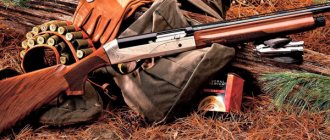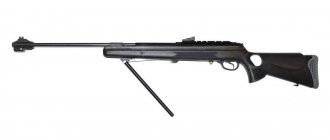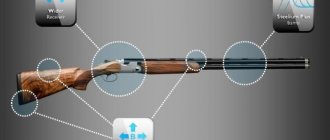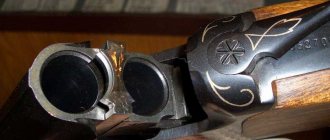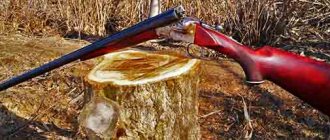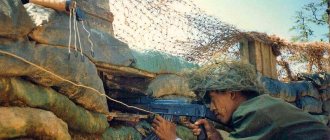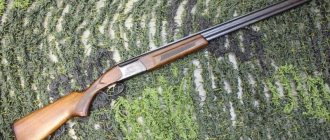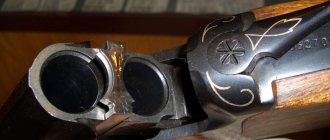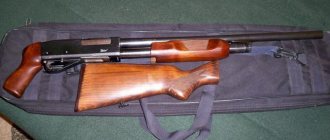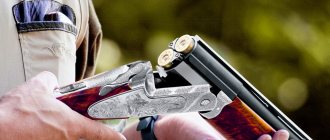When sanctions came into force, the cost of all imported goods increased sharply.
In addition, prices began to rise for weapons chemicals, that is, everything that hunters need to clean weapons. The market for these goods has become much poorer. The plight gradually eased as domestic producers became more active. However, no one knows about them, so they do not inspire confidence as much as foreign goods. The cost of domestic chemicals is also quite high, although they are cheaper than imported analogues.
After reading this article, you will learn how to clean your gun. Forget about Ballistol, I make the product 15 times cheaper. A friend taught me and now I do the same.
Removing rust and small shells from a gun barrel
These defects mainly affect old guns that did not have a good coating, and therefore their barrels were severely damaged by corrosion.
V. Barsukov (“Weapons and Hunting,” No. 4, 1994) developed his own method of extending the life of rusty trunks.
The method can be roughly divided into three operations.
♦ Removing rust from surfaces not affected by shells. It is carried out using a nozzle in the form of a ramrod and fine emery cloth on a fabric basis, wrapped around a nozzle on a foam rubber lining, and an electric drill. A rotating cleaning rod is moved along the barrel using a drill until the rust disappears.
♦ Removing rust from sinks. You can remove rust from a sink either using a metal brush made of steel wire, rotated with a drill, or using a rust converter, which is more effective. In addition, it creates a microscopic film on the surface of the sinks, which prevents the aggressive effects of substances on the metal.
♦ Application of a chemical preservative. The automotive preparation Movil-2 is used as a preservative, which is also capable of reacting with rust - iron oxide; in addition, it partially neutralizes the combustion products of the primer. "Movil-2" when applied has a liquid consistency and then hardens. The Movil layer, located in unaffected areas, is erased during shooting, and remains in the shells, protecting them from further corrosion. The coating must be renewed periodically.
Shotgun barrel adjustment
Shustovka is an operation for mechanical removal of shells from the bore up to 0.1 mm deep.
Shustovka is carried out using a shustovka (lapping), which is made specifically for this purpose.
Using a cast iron shank is very dangerous, since it cannot be stopped during operation, even for a few minutes. With such a stop, it can be “grabbed”, and it can only be removed by drilling, and in this case the barrel can be completely damaged.
The best material for shust is textolite. The shust is sharpened along the inner diameter of the barrel with a longitudinal hole with a taper of 1:50 or 1:100, on one side it is cut along the length. The metal mandrel is sharpened along the cone of the hole so that the cone fits halfway into the sleeve.
In the thick end of the mandrel, a hole with an M8 thread is made, into which a pin is screwed into which serves as the lapping driver - a long copper or steel rod with a thread at the end.
From the thin end of the mandrel, a hole is made with an M8 thread to a depth of 25–30 mm, into which an M8 screw is screwed through a washer. This screw is used to expand the lap by retracting the mandrel.
To remove shells with a depth of 0.1 mm, it is necessary to make 3–4 laps. The abrasive used for the work is additional paste or very fine emery powder. The lubricant is mineral oil.
Shustovka is made by rotating the post and moving the lapping back and forth along the barrel in the area from the chamber to the beginning of the choke. To avoid a ledge on the shank in this place, a cone is made in the front part over a length of 4–16 mm to a diameter of 18 mm, and a movement limiter is made on the post.
Rice. Shust (lapping): 1 — PCB bushing; 2 — steel mandrel; 3 — socket for the tension screw; 4 — socket for the post; 5 - tension screw; 6 - washer
At the end of the shustovka, a third or fourth shust is applied, onto which GOI-30 micron polishing paste with kerosene is applied, the shust is moved longitudinally along the barrel without rotation, only turning it after each movement by a certain angle.
After polishing, the barrel looks like new. The inside diameter of the barrel increases by 0.2 mm, and the wall thickness decreases by 0.1 mm. Therefore, before making noise, you need to check the thickness of the wall at the thinnest point, and if it is less than 0.8 mm, then such a barrel cannot be made.
Also, very light guns and old guns, especially those with Damascus barrels, should not be used.
Barrel straightener by I. S. Mikerin: A - removed barrel with inserted cylinder; B - cylinder with an inserted cone; B is a cylinder having an internal cavity with a ledge into which a cone is inserted; G - cross section of the cylinder; D - metal cleaning rod-impactor (size A is 3 mm less than the barrel diameter); E - location of the rectifier in the barrel bore; 1 - trunk; 2 - cylinder; 3 - cone; 4 - twine
Straightening out dents in a gun barrel
In periodical printing there are two ways to eliminate this defect.
To remove dents, I. S. Mikerin designed a rectifier, which consists of a cylinder and an expander.
The cylinder, turned on a lathe, has a diameter 0.25 mm less than the diameter of the bore. At one end the cylinder has a cone, and at the other it is only rounded. The surfaces of the cylinder and cone are polished. A cylindrical or conical hole with a ledge is drilled inside. The cylinder has a cut along the entire body, which is made with a hacksaw. The material for the cylinder is steel, iron or brass.
A steel conical expander is ground into the cavity drilled inside the cylinder.
The action of the rectifier is as follows: the rectifier with its conical side is inserted into the channel from the side of the chamber a-a. Bringing the straightener to the dent, it is lightly struck with a ramrod by the striker.
When the rectifier is brought to the desired place, i.e. the dent is in space a-a (rectifier), an expander cone is inserted into the rectifier channel and, supporting the rectifier on the other side, they begin to tap the cone with the same ramrod, causing the rectifier to expand and press on the dented area of the barrel - this way the dent is straightened. A piece of burnt copper is placed on top of the dent and struck with a hammer.
If the work was done carefully, the dent will be corrected.
The second method is proposed by V. Pankratov. Its essence is as follows. To straighten the dent, a bushing is made, as for shimming a barrel, but only from bronze or steel about 100 mm long; its internal cone must be turned with a reamer of 1:50% or 1:1%. The walls of such a sleeve should be no thicker than 1.5 mm at their widest point. The sleeve is also cut to length on one side. The steel conical mandrel should extend into the bushing no more than 70mm. The mandrel is drilled with a blind hole at both ends and tapped with an M8 thread. The depth of these holes at the wide end should be up to 25 mm, and at the thin end - 40–50 mm or more. The outer diameter of the bushing should be along the barrel minus the size of the dent.
A post of such length is screwed into the rear end of the mandrel that a bushing can be installed under the dent. The other end of the post should be bent at a right angle at a length of 150–200mm. The shtrevel is secured to the mandrel with a locknut. The mandrel is like for shustovka.
Another post, also 8mm in diameter with a thread at the end, has a round nut with a diameter of 18mm, screwed onto the post until it stops.
The shtrevel is wound through the muzzle end of the barrel. A washer with an outer diameter of 18 mm is put on the thread of the post. After installing the post, the free end of the thread should be 8–19 mm.
The shtrevel is inserted into the barrel through the barrel and screwed into the mandrel until it stops in the sleeve. When the rear end of the post is secured or an assistant holds it with his hands, they begin to rotate the second post, screwing it into the mandrel. The mandrel will be pulled into the bushing and straighten out the dent.
In this case, from time to time you need to tap the outer area of the dent through the copper plate with a hammer with light blows. The copper plate does not need to be annealed. From time to time it is necessary to change the number of washers on the post.
If the dent cannot be straightened, then change the bushing to a size of 18.3mm or 18.4mm.
When the dent is repaired, it is usually invisible. Under no circumstances should you poke around the dent area. This leads to a weakening of the barrel wall.
If the dent was caused by an impact that damaged the outer surface of the barrel, then it cannot be corrected.
MAKSIMOV.SU
“Tell the sovereign that the British don’t clean their guns with bricks: let them not clean ours either, otherwise, God bless the war, they’re not good for shooting.”
“The Tale of the Tula Oblique Lefty and the Steel Flea.”
N.S.
Leskov, 1881 Leskov was wrong - in the Russian army they cleaned weapons and did it competently.
At least, the methods excluded cleaning the barrel with any abrasive, as evidenced by documents of that time.
Here's how to clean the weapon
in our hunting environment it is still on the “outside” of priorities. You can still hear that the barrel of a rifle or shotgun can be “cleaned with a shot” and in general this is not a man’s business. Simply put, some hunters cover up their ignorance and laziness with dense myths.
Neglected double-barreled shotgun barrels:
there is corrosion, chrome is peeling and crumbling, there is a rash and small shells
Proper weapon care
increases its reliability, extends its service life significantly and, importantly, maintains liquidity. A well-maintained gun can be sold quickly and at a high price, while damaged junk is most often sent for melting down or for spare parts.
This article is about
How to clean a shotgun correctly and without extra costs
.
CHISTOGUN products and tools
for cleaning guns. Made in Russia
Soviet school
on cleaning a gun
Necessity
Experts and advanced hunters were aware of proper gun care back in the 19th century. The promotion of “proper hunting” has always kept pace with the promotion of weapon conservation techniques.
In that
there was nothing new or unusual - by that time firearms had been used in hunting for more than 300 years. And the principles of preserving appearance and performance came to “firearms” from the era of edged weapons, during which people knew a lot about cleaning and preserving metal.
Vischer of a one-piece ramrod from the stem of the svidina, the ramrod was made by my father
about 40 years ago
But the norms
rules and good wishes are one thing. But when it comes to practice, the situation changes. Moreover, this happens regardless of the country or historical period - people are the same by nature.
If 150 years ago
In many countries of the world, ownership of hunting weapons was the lot of aristocrats, but in the 20th century, representatives of less privileged classes also began to hunt for sport. Expensive weapons received more attention; mass-produced guns were most often viewed as expendable tools.
Aerosol solvents and oils are convenient for cleaning weapons not only in the field, but also at home
Under Soviet rule
hunting has been given great importance since the 1920s. The country needed furs, which, as before, provided a significant share of the currency.
In propaganda
commercial and sport hunting also had another practical meaning: a hunter is a ready soldier: hardy, skillful, with excellent marksmanship training.
To clean your gun, choose a cleaning rod of optimal length.
In the photo - a cleaning rod for cleaning shotguns from the CHISTOGUN company
Saving problems
army weapons were actively discussed in various publications even under the tsarist regime. There was no smell of specialized “chemistry” at that time; discussions were centered around such cleaning products as soapy water and kerosene.
Force
It was almost impossible for a soldier to treat weapons with love. But a hunter drafted into the army does not need to be taught and forced to take care of his rifle - he himself knows and understands everything.
CHISTOGUN felt wad patches
effectively remove not only carbon deposits, but also lead
That's why
just a few years after the October Revolution of 1917, specialized books for hunters began to come out of print one after another. Newspapers and magazines were published at the union, republican and district levels. Shooting ranges were built en masse, hunting societies and shooting organizations were created. The state was on the side of the hunters.
A modern “Italian” cleaning rod, apparently made in China
War
temporarily suspended this activity. But already in 1943, when the turning point in the war became obvious, the production of hunting weapons was resumed in Izhevsk - the country was in dire need of meat and, as before, currency. By 1945, hunting weapons were mass-produced, both converted from combat systems, and in the form of classic single-barreled and double-barreled guns.
At the end of the 1940s.
The USSR was experiencing a boom in book printing. Scientific, technical, educational and historical literature and works of classics were published in huge editions. Much attention was still paid to the hunting theme.
Heyday
Soviet hunting economy occurred in the 1960-1980s. It was during this period that a huge amount of high-quality hunting literature was published, in which, incl. The topic of weapon care was exhaustively covered. All old recommendations are still relevant today.
An old grandfather's cleaning rod made in the 1960s: strong, reliable, easy to use.
But, due to the difference in threads, there are difficulties with using modern brushes, that is, adapters are needed
Modern approach
In our time
the selection of tools, consumables and special oils is incomparably greater than what was on the shelves of hunting stores back in the 1990s, not to mention the Soviet period.
Chemicals
for cleaning weapons "Neva"
Besides
wanting to make money from hunters, manufacturers are really trying to make our lives easier. If you clean your gun with a comfortable cleaning rod, using high-quality attachments and effective chemistry, this process will be shorter and more effective.
Complete cleaning
rifled weapons without modern tools and “chemistry” is generally impossible, but this is a topic for another article.
Another manufacturer of domestic weapons chemicals
In our time
The process of saving weapons has become simpler and more efficient. Traditions are good, but in this case you definitely shouldn’t neglect progress. But you need to spend a little.
Tradition and innovation
Ramrod
Main tool
For high-quality cleaning of the gun - a good cleaning rod. We will also need various brushes, vishers, puffs and adapters.
I am writing these lines
April 15, 2022, when coronavirus psychosis in Russia reached its peak. Import supplies have been stopped. Enterprises that were at least partially dependent on foreign components are and will continue to “slip” for some time even after the supply situation normalizes.
Modern double-knee cleaning rod
produced by the Russian company CHISTOGUN
But it’s already clear
— the world has changed, globalization has proven its failure and danger for national economies. It is not without reason that during the Soviet period the emphasis was placed on so-called closed-cycle enterprises.
Factories
with a full production cycle and will now be in a better position. Now the essence of effective import substitution will be fully clear to everyone.
Screwing a 12-gauge felt patch onto the adapter needle of a CHISTOGUN
In a niche
hunting equipment, one of the most striking examples of substitution of imported goods is CHISTOGUN products. In short, this manufacturer was able to start producing tools and consumables for cleaning weapons, of world-class quality and several times cheaper than similar imports.
These guys
They themselves are hunters and high-precision shooters, that is, they know a lot about proper cleaning and the tools for this.
I bought this cleaning rod in 2000
for the Saiga-20S. The ramrod turned out to be short, I had to grind out an extension
Fact
— the gun can be cleaned with a homemade cleaning rod made from the stem of a pigweed. A Soviet aluminum cleaning rod can handle this even better. I love the magnificence of my grandfather's wooden cleaning rod, which comes apart into 3 parts, has a pronounced handle and a steel rod in a wooden shell. There are Chinese wooden and plastic “three-knees” on sale, which do not last long, but are passed off as “made in Italy”.
It would seem
- Well, what can be invented in such a simple matter as a rifle ramrod? The question here needs to be posed on a different plane - what should it be like, an ideal cleaning rod for a shotgun? There is an answer: such a tool should be lightweight, durable, adaptable to modern attachments, regardless of the manufacturer.
One of the most effective tools
for “rough” cleaning is still the spiral bronze brush
Good cleaning rod
should not damage the weapon, but must be convenient and affordable. The best cleaning rod is a solid one, but many hunters prefer a composite one. This means that the collapsible structure should not unwind spontaneously. It should provide the necessary rigidity of the rod.
Classic brushes
designed for cleaning guns
Watch the gun
My grandfather taught me. Returning from hunting, he sat down at the table only after thoroughly cleaning his weapon. We then cleaned the “Frolovkas” and “Tulkas” with solid pork ramrods, pieces of rags and “Capercaillie”. Then I got experience using all the cleaning rods that were on sale or inherited from friends.
Cleaning rod for cleaning the chamber.
A useful thing, although probably made in China
Eventually
There is only one left in operation - Soviet, collapsible, in a canvas case, from the 1960s. It had two drawbacks - incompatibility with modern attachments and excessive weight - due to the heavy steel rod, which gave the cleaning rod impeccable rigidity.
In 2022
I updated the gun cleaning tool based on my personal ideas of beauty. For home cleaning, a modern one-piece cleaning rod was purchased, and for cleaning weapons while hunting, a dismountable, two-armed one was purchased. Both products are from the already mentioned CHISTOGUN brand.
Even double-barreled shotgun barrels
can be cleaned on a special machine designed for the care of rifled weapons
Cleaning rod base
— steel rod in a polymer sheath. Plastic handle, modern carving. What’s important is that this manufacturer offers a modern take on attachments for its cleaning rods—from needles for felt patches to vischers for flannel napkins. There is a huge selection of adapters for brushes of any type. In my opinion, these cleaning rods are the ideal option for cleaning a gun.
Felt patches
and a hard cleaning rod from CHISTOGUN
Weapons chemistry
Weapons chemistry
consists of various oils and solvents (solvents). Using a variety of these substances to clean your gun is completely normal. No one is embarrassed by the current abundance of household chemicals, whereas 30 years ago we got by with bar soap, bleach, blue and “Myth”.
Weapons chemicals from the domestic manufacturer Treal-M are currently one of the best on the market
Same with weapons
, and in general - with any technology. But for some reason, our hunters do not consider it shameful to spend a lot on auto chemicals for their favorite jeep, but in the case of weapons, the “chemical” enthusiasm disappears somewhere.
Weapons "chemistry"
- a necessary thing. Of course, when cleaning a double-barreled shotgun, you can get by with alkaline and neutral oils. But specialized solvents remove carbon deposits and lead much more effectively, and modern oils better protect against rust, thereby more reliably preserving the barrels of old guns. Which path to choose is a personal matter. But if you love your gun, why not pamper it a little?
Russian-made weapons “chemistry”
Until recently
weapons care products on our market were divided as follows: all modern “chemistry” is imported, standard alkaline and neutral oils are Russian. This couldn't go on for long.
And today
You can completely get by with domestic products that are produced by several manufacturers - search on the Internet, you will be surprised at the choice. Both effective and much cheaper.
Another set of
domestic weapons “chemistry” from Treal-M
Consumables
Earlier
The only consumables for cleaning the gun were old rags - old sheets were considered the best - washed, soft, from clean "he-be". Today, rags have not lost their relevance.
But there is progress here too
— Manufacturers offer neatly cut flannel napkins. They are quite small in size, but require a special caliber visor. Convenient and quite affordable.
Special nozzles CHISTOGUN
for cleaning smooth-bore weapons.
CHISTOGUN
cleaning rod is also designed for cleaning guns. Made in Russia
CHISTOGUN wipes and visher
for cleaning shotguns
Absolutely
Felt patches have become a new type of consumables for cleaning shotguns. These are ordinary over-caliber wads, only white and with a through hole in the center. The use of such patches also requires a special attachment - an adapter needle. The thing is inexpensive, easy to use and effective.
On the cleaning rod there is a CHISTOGUN needle-adapter
designed
for winding felt patches
Two felt patches on the CHISTOGUN needle adapter
are fixed with a special nut
Work algorithm
It’s simple: put the wad on the needle, tighten the locking nut, spray some solvent oil into the barrel and drive it back and forth with a cleaning rod. Felt is an excellent substitute for a spiral brush. It perfectly removes carbon deposits from metal. Thousands of felt fibers penetrate microscopic shells, cleaning out all the nasty stuff.
Cleaning a gun in the field
using a modern cleaning rod CHISTOGUN and felt patches from the same manufacturer
With strong lead contamination
trunks or visible carbon deposits of plastic from container wads, the cleaning scheme will be a little more complicated. First you need to soak the barrel with lye oil or modern solvent oil. Then, using a spiral bronze brush, we remove the lead, plastic and carbon deposits at once.
Next we spray/spray
into the barrel with some oil, take a cleaning rod with a felt patch and drive all the dirt out of the barrel. We put a new patch on the needle, moisten it with oil with high penetrating ability (you can use dehydrated kerosene, VeDeshka, alkaline or neutral Capercaillie) and make a dozen or two frictions back and forth. Felt will clean out residues of carbon deposits, lead and plastic from the shells and pores of the metal.
Cleaning double-barreled
shotguns with felt patches CHISTOGUN
After
We take a clean rag or a ready-made flannel napkin, run it through the barrel a couple of times, wiping it dry from chemicals and remaining dirt. That's it, the cleaning is finished, all that remains is to lubricate the bore with any neutral oil.
Pay attention
to how deeply the CHISTOGUN felt patch
With absence
With such gun oils, a neutral “motor” can be used. But here you need to be careful - automobile oils often contain various additives that can adversely affect the steel of the barrels. It’s better to use at least a “Capercaillie” or a “spindle”.
Felt patch moistened with oil on a flexible cleaning rod CHISTOGUN
Briefly about the methodology
With a small shot,
that is, within 10-20 shots, it is enough to remove carbon deposits and lead from the barrel bore. To do this, you need to push 2-3 patches with the appropriate solvent (or alkaline oil) through the barrel, then make 15-20 passes with a bronze brush.
Further
We also wet the brush with solvent/alkali and make another 20 passes along the barrel. We wipe the bore dry. If necessary, we repeat everything from the very beginning.
Guns
love cleaning and lubrication.
On practice
Butch's solvent or any Russian equivalent removes carbon deposits with a bang, and with it lead and plastic. If suddenly the solvent does not cope with lead, you can use Shooter's Choice Lead Remover, which removes lead well using the same scheme. At the end of the work, lubricate the bore with oil.
A variety of adapters CHISTOGUN
for various brushes and vischers
Choki
are cleaned of carbon deposits and lead during the main cleaning of the barrel. Then you need to unscrew the chokes and thoroughly clean all the places where they connect to the barrel.
In that
A carbon remover and a bronze brush like a toothbrush will help. We wet it, waited, rubbed it with a brush, wiped it off, lubricated the threads with neutral oil, and tightened the chokes. And don’t forget to clean the chambers and the “forehead” shield, this is important.
The folded flexible CLISTOGUN cleaning rod
takes up little space and weighs almost nothing
If replaceable chokes
soured tightly, try boiling the muzzle of the barrels for 5 minutes, then twist. You can heat it with a hair dryer, but be careful - don’t unsolder the trunks.
Sometimes they help
medium-force blows on the end of the choke with a hammer through a piece of wood. There are special auto chemicals on sale, but you need to be careful with them.
Flexible cleaning rod CHISTOGUN
in use
Polishing
shotgun
Polishing
reduces the likelihood of accumulation of combustion products of gunpowder, lead and plastic. Polished barrels are easier and faster to clean. It is better to polish immaculate trunks - without shells, peeling chrome and other damage.
For polishing barrels
You need a strong, long cleaning rod, preferably a solid one. You will need a needle for cylindrical felt patches, the patches themselves, any oil and polishing paste. We install the patch, moisten it with oil, apply the paste, carefully insert the patch into the barrel from the chamber side and make 50 frictions, trying to prevent the patch from being removed from the muzzle of the barrel. We change the patch, reapply the paste and again 50 frictions.
Special needle adapter CHISTOGUN
for felt patches intended for cleaning smooth-bore shotguns
For black trunks
Usually 200-300 passes back and forth are enough, chrome ones require at least 500-600 frictions. The entire process takes about 2 hours and requires some stamina. In return, you get beautiful trunks, which will then require less time for proper cleaning.
I used
l imported polishing pastes JB (red) and Iosso. Among the domestic ones in our market, I saw “Titan” paste. I haven’t tested it personally, but the reviews are good and the price is affordable.
Cleaning the barrel of an MP-155 shotgun using a flexible cleaning rod CHISTOGUN
in the field
Conclusion
Well maintained gun
- a sign of good manners and a guarantee of performance. A cleaned gun is always nice to pick up. With proper care, you will pass on your favorite double-barreled shotgun to inheritance. And not only for my son, but also for my grandson. Agree, it is expensive.
Needle adapter
and felt patch CHISTOGUN
Total cleaning
double-barreled shotguns takes about half an hour. There is no energy for normal cleaning - “soak” the barrels overnight with some oil, this will stop corrosion. But this is an extreme case that can only be justified by exceptional circumstances.
Due to its strength, the flexible cleaning rod is capable of pulling a felt patch through the barrel with great force
If you have a gun
with chrome-plated barrels, this does not mean there is no need to clean them. Sooner or later, even in chrome-plated barrels, shells appear, which quickly progress and ultimately quickly lead to the death of the gun.
Cleaning weapons is a serious matter, requiring knowledge, high-quality tools, effective consumables and some skills
The article was published in the updated magazine “Hunting”, No. 2 for 2022
Straightening out bulges on a gun barrel
This operation is more complicated than fixing a barrel dent. V. Pankratov recommends straightening the bulge using the same mandrel as the dent. But the metal that is stretched needs to be upset, which is much more difficult to accomplish.
After installation at the expansion point of the device, they also begin to push the metal through the copper gasket with small, light blows (preferably with a hammer weighing 200–250 g) until it settles completely.
Swellings larger than 0.5 mm cannot be corrected; they can only be reduced. The most dangerous swellings are swellings of trunks in the first third of their length, i.e. at a distance of 200–300 mm from the breech (with a trunk length of 75 cm) and further to the middle. It is possible to straighten these swellings, but after this the barrels do not last long - they will swell or rupture when fired.
If a slight swelling of the barrels occurs in the last third of the barrels, closer to the muzzle, or even in the thinnest place, but without cracks, then it can almost always be straightened out without any significant consequences for the strength of the barrels.
Modifications
Today, the produced IZH weapons are known as MP 43 with a caliber of 12 mm and a chamber length of 70 (76) mm. There are versions of the MP 43 for 16 gauge and a 70 mm chamber, and for calibers 20 and 410 mm there are 76 mm chambers. Note that IZH 43 versions 410/76 are produced with barrel drilling in two options - 0.25 cylinder and payload or 0.75 and choke.
The barrel length of the MP 43 varies in the range from 510 to 750 mm, but products with a maximum barrel length are produced only for 12 gauge. The remaining samples differ in the maximum barrel length of 71 cm.
The main modifications of IZH 43 include:
- gun IZH 43 E (MR 43 E) - the basic version, equipped with a switchable selective ejector, which, when opening the barrel, removes only the spent cartridge case. The entire ammunition remains in the barrel, which makes quick reloading convenient;
- IZH 43 1 S (MR 43 1 S) is a gun with one trigger. The sequence of shots from each barrel is easily switched, the switch is mounted in the upper part of the trigger itself;
- IZH 43 E 1 S (MR 43 E 1 S) – an analogue of the previous model, equipped with an ejector;
- IZH 43 K (MR 43 K) – a gun with external false triggers. It is popular among those who transport weapons in a loaded state and prefer to quickly cock the mainsprings without opening the gun. It should be noted that, unexpectedly for everyone, American fans of historical guns became interested in this model, and there are known references to models with fake fire tubes, produced with the expectation of the demand of this particular sales market;
- IZH 43 EM - the main difference from the IZH 43 M is the mechanism that automatically ejects spent cartridges.
Samples IZH 43 M, IZH 43 EM, IZH 43, IZH 43 E, MR 43 “Prestige” can be manufactured in regular, piece and export versions. The weight of shotguns for 12 gauge does not exceed 3.3 kg, and IZH 43 M for 16 gauge weighs no more than 3.2 kg.
Eliminating wobble in gun barrels
The wobbling of the barrels appears due to wear on the front hook of the gun. Wear of the hook leads to longitudinal wobble of the trunks.
Longitudinal wobble can be eliminated only by installing a new bolt of increased size. To do this, you need to ream the hole, cut the thread and install a new bolt.
To change the bolt this way, you need to do the following work. First, determine how much the diameter of the bolt needs to be increased. To do this, pieces of paper are thrown into the recess of the front hook until the wobbling is eliminated. Then the thickness of the paper is measured, doubled in size and added to the diameter of the bolt, thus obtaining the required diameter for the new bolt.
A reamer is made according to the diameter of the bolt with a tolerance of 0.05 mm, and then proceed as described above.
In the short term, wobbling can be eliminated in an easier way: the recess of the hook is tinned with tin using a soldering iron. To do this, you need a large electric soldering iron with a replaceable straight rod made of red copper, which is filed 1–2 mm smaller than the diameter of the recess. Large electric soldering irons have a tip with a diameter of 8 to 10 mm. The hinge bolt on most shotguns is 8 to 10mm.
The surface of the recess is cleaned, degreased with acetone, lubricated with soldering acid and a piece of tin (pure, free of lead) is inserted into it.
The hook must be heated so that when touched by ammonia, the hook begins to smoke strongly. You need to tin the soldering iron, and then, touching a piece of tin in the hook recess and melting it, tin the entire plane of the hook recess.
It is possible that the operation will not be successful the first time. In this case, it is necessary to clean the blackened areas without touching the tinned ones, and repeat the tinning again.
Having tinned the hook, adjust it to the bolt with a triangular scraper, which can be made from a small triangular file or from a round steel rod with a diameter of 8 mm cut into three edges. The scraper is tempered to yellow color by heating the rod below the sharpening point.
When working with this scraper, you need to place it on one of the planes, then one of the edges will be cutting, and the other will be a guide.
Lateral wobble also appears from wear on the side planes of the front hook. It is usually irremovable. However, you can try to remove it by tinning both sides of the front hook with a regular soldering iron or a large electric soldering iron. This is done after eliminating the longitudinal wobble at the hinge of the gun.
It is also necessary to tin the side planes of the front hook and adjust it so that the lateral wobble stops. After this, it is necessary to tin the side planes of the rear hook, but here you will need a thicker layer of tin.
Then the hooks and barrel should be washed thoroughly with water and soda to avoid rust.
Soldering sighting strips to the gun barrel
The method of soldering strips is described according to V. Pankratov. The factory soldering of the straps is disrupted either by the vibration of the barrels when fired, or by alkaline oxidation. When soldering, the strips come into contact with a very narrow strip no more than 2 mm wide.
If the area of the torn strip at the end of the barrel is small, then you can try to solder it without tearing it off completely. To do this, you need to insert the sharp end of the knife into the soldering area and lift the bar, then moisten the lagging area several times with alcohol or ether. Then the soldering area is moistened with a solution of rosin in alcohol and, after allowing the alcohol to evaporate, a sharp soldering iron, heavy enough to maintain the temperature, is soldered with solder.
If the lags of the strip are large or located in the middle of the trunks, then such strips must be soldered. The strips are desoldered by heating the seams with a sharp soldering iron. The strips and soldering points on the barrel are cleared of tin.
Having cleaned the soldering points at the straps and on the barrels, check the tightness of the strap to the trunks. If fit
If the straps are loose, they are adjusted so that the strap in place fits snugly against the trunk.
Fitting is carried out as follows: the trunks are smeared with soot (soot is black paint diluted with mineral oil), mixed with mineral oil to the consistency of liquid sour cream. The plank is placed in place without pressure and the place where there is a soot imprint is filed with a flat file. This is done until the entire strip fits tightly to the entire trunk. The gaps where the bar is not adjacent to the trunks should be no more than 10–12 mm along the entire trunk.
Having attached the fitted strips to the trunks, they are secured in place with clamping clamps. Soldering areas must first be cleaned of oxidation and degreased.
Soldering is carried out with soft solder: 2 parts tin, 1 part lead. Instead of acid, take rosin dissolved in alcohol. Having moistened the soldering areas with this solution, let the alcohol evaporate and use a hot soldering iron to make a soldering joint 5–6 cm long, first on one side of the bar, and then on the other. The shadow rings are used to check whether the trunk has moved.
It is better to start soldering from the breech. Then they make a second soldering at a distance of 5–6 cm from the first, each time checking after applying the seam whether the trunks have moved. This continues until the end of the trunks.
After soldering is done and the barrels are checked for correctness, you can connect the dotted seams on both strips.
Usually on one of the strips (bottom) of horizontally welded trunks or on one of the side strips of vertically welded trunks there are holes for the release of hot air. The presence of these holes is very important, because otherwise, when the last seam is applied, the planks will come off under the pressure of the hot air remaining under them.
After soldering is completed, carefully clean the soldering areas from solder using coarsely notched files and fine sandpaper, without touching the metal of the barrels. If the solder is not completely cleared from the barrels, then oxidation will not work in these places.
It is impossible to use zinc chloride, or, as it is called, etched hydrochloric acid, when soldering, since if it gets under the slats, it will cause rust of the barrels.
Sometimes soldering of barrels (bars) is done using heating elements. This is a long porcelain tube, about 10 mm thick, covering the entire length of the barrels, on which a chrome thread with ceramic insulators (beads) is wound, as in electric stoves. In this case, the wire winding in the treasury should be dense for 150 mm, gradually becoming more uniform until it takes off. One of these heating elements is taken into each trunk. The heating elements are secured and centered in the trunks. Then the current is turned on through the rheostat and the barrels are gradually heated.
Solder in the form of a paste with rosin is applied to the edges of the strips and, gradually heating the heating elements, the barrels are heated to the melting temperature of the solder. As soon as the solder has melted and penetrated into the grooves (this happens very quickly), the current is turned off.
The soldering is good, the solder consumption is small, and cleaning is much easier.
Specifications
The IZH 43 hunting rifle has the following parameters:
- production is established in two calibers - 12 and 16 mm;
- chamber length, mm – 70 and 76;
- gun weight – within 3.6 kg;
- trunk length, mm – 660, 720 and 750;
- fired - from 15,000 shots;
- assembled gun length, mm – no more than 1,300.
The IZH 43 barrels are removable type, with a horizontal arrangement, their connection is made by means of a sighting and lower strip. The breech of the head is connected by a coupling and pressed into place with an incoming pin.
Double closing of the barrels is carried out by a locking bar on two under-barrel hooks. Shotguns are available with or without selective ejectors. In the second option, the ejector does not work; the cartridges are removed by hand.
The IZH 43 shotgun has good shooting accuracy
